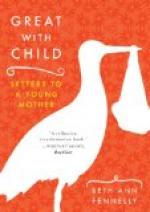“Think,” says Dr. Buchan, “of the immense number of children that die of convulsions soon after birth; and be assured that these (its cries) are much oftener owing to galling pressure, or some external injury, than to any inward cause.” This same writer adds, that he has known a child which was “seized with convulsion fits” soon after being “swaddled,” immediately relieved by taking off the rollers and bandages; and he says that a loose dress prevented the return of the disease.
I think it is obvious that the utmost extent to which we ought to go, in yielding to the fashion, as it regards form, is to use three pieces of clothing—the shirt, the petticoat and the frock; all of which must be as loose as possible; and before the infant begins to crawl about much, the latter should be long, for the salve of covering the feet and legs. At four or five years of age, loose trowsers, with boys, may be substituted for the petticoat; but it is a question whether something like the frock might not, with every individual, be usefully retained through life.
I wish it were unnecessary, in a book like this, to join in the general complaint against tight lacing any part of the body, but especially the chest. But as this work of torture is sometimes begun almost from the cradle, and as prevention is better than cure, the hope of preventing that for which no cure appears yet to have been found, leads me to make a few remarks on the subject.
As it has long been my opinion that one reason why mothers continue to overlook the subject is, that they do not understand the structure and motion of the chest, I have attempted the following explanation and illustration.
I have already said, that if we bandage tightly, for a considerable time, any part of the human frame, it is apt to become weaker. The more a portion of the frame which is furnished with muscles, those curious instruments of motion, is used, provided it is not over-exerted, the more vigorous it is. Bind up an arm, or a hand, or a foot, and keep it bound for twelve hours of the day for many years, and think you it will be as strong as it otherwise would have been? Facts prove the contrary. The Chinese swathe the feet of their infant females; and they are not only small, but weak.
I have said their feet are smaller for being bandaged. So is a hand or an arm. Action—healthy, constant action—is indispensable to the perfect development of the body and limbs. Why it is so, is another thing. But so it is; and it is a principle or law of the great Creator which cannot be evaded. More than this; if you bind some parts of the body tightly, so as to compress them as much as you can without producing actual pain, you will find that the part not only ceases to grow, but actually dwindles away. I have seen this tried again and again. Even the solid parts perish under pressure. When a person first wears a false head of hair, the clasp which rests upon the head, at the upper part of the forehead, being new and elastic, and pressing rather closely, will, in a few months, often make quite an indentation in the cranium or bone of the head.




